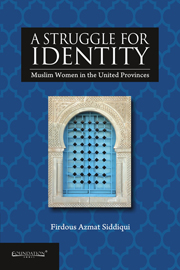Book contents
- Frontmatter
- Contents
- Acknowledgements
- Introduction
- 1 Social Stratification of Muslim Women in the United Provinces
- 2 Socio-religious Movement and the Muslim Women's Issue
- 3 British Perception of Muslim Women: Questions of Fecundity and Health
- 4 Crises in the Social and Economic Identity of Muslim Women: The Great Uprising of 1857
- 5 Changing Profile of Muslim Women through Education
- 6 Patriarchy and Social Obligation of Indian Muslim Women
- 7 Cultural Clash: From Tawaif to Kasbi
- 8 Law, Land and Muslim Women: The Economic Situation
- 9 Muslim Women's Response to the New Judicial System
- Conclusion
- Glossary
- Bibliography
- Index
1 - Social Stratification of Muslim Women in the United Provinces
Published online by Cambridge University Press: 05 October 2014
- Frontmatter
- Contents
- Acknowledgements
- Introduction
- 1 Social Stratification of Muslim Women in the United Provinces
- 2 Socio-religious Movement and the Muslim Women's Issue
- 3 British Perception of Muslim Women: Questions of Fecundity and Health
- 4 Crises in the Social and Economic Identity of Muslim Women: The Great Uprising of 1857
- 5 Changing Profile of Muslim Women through Education
- 6 Patriarchy and Social Obligation of Indian Muslim Women
- 7 Cultural Clash: From Tawaif to Kasbi
- 8 Law, Land and Muslim Women: The Economic Situation
- 9 Muslim Women's Response to the New Judicial System
- Conclusion
- Glossary
- Bibliography
- Index
Summary
Ek hi saf me khare ho gae sab Mahmud-o Ayaaz
Na koi banda raha aur na koi banda nawaaz.'
Mahmood and Ayaz stood together in the same flank
The ruler and the ruled forgot the difference in their rank.
Banda O sahib-o Muhtaj-o ghani ek hue,
Teri sarkar me pahunche to sabhi ek hue.
The rich and poor, lord and slave, all were leveled down,
All became brethren in love, with thy grace crowned.
Can all Muslims be referred to as a monolithic bloc? Although all the women who can be classified as ‘Muslim’ adhere to Islam and its customs, is it an adequate basis for referring to them as a collective entity, or placing them within an undifferentiated category? Are there no differences of caste, social class or region among them? Is it not true that in culturally, socially and economically progressive regions, the status of Muslim women is better than in the regions that have experienced no such development historically? Is it not time for researchers to explore how these differences affect these women's status—within the same or different regions of India?
The answer to these questions lies in comprehending the significance of social stratification amongst the Muslims. The first question that comes to mind is, ‘Who is the Indian Muslim/Musalman?’ The definition provided in colonial deliberations and census reports is: ‘One who eats cow, who hates pork, who believes in one God and does not believe in idol worship; whose men keep beards and wear skull-sized caps, and whose women wear a burqa.’ The general perceptions that form Muslim identity state that Muslim women are veiled, as opposed to the unveiled Hindu women, as Muslims always do the opposite of what Hindus do.
- Type
- Chapter
- Information
- A Struggle for IdentityMuslim Women in United Provinces, pp. 1 - 17Publisher: Foundation BooksPrint publication year: 2014

